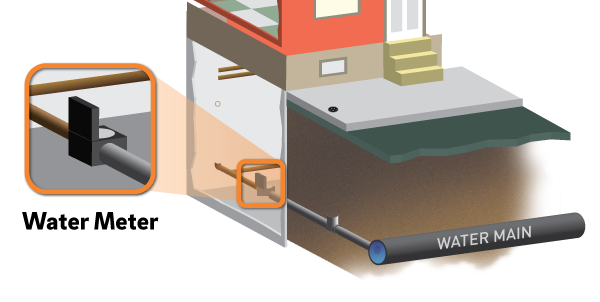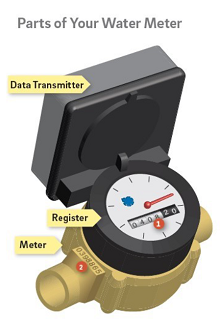Checking for Leaks
High water bills can be caused by small leaks from household fixtures like toilets, sinks, or hoses, or with a change in your regular water use.
Remember, the Philadelphia Water Department is not responsible for pipes inside your home. We cannot verify that you have a leak, nor can we repair leaks in your home.
Mind your Meter
Your home’s water meter measures the amount of water that flows into your home each month – the more water that’s used, the more flows in. So the more the meter measures, the more your bill increases. It’s similar to the odometer on a car – the more you drive, the higher the number goes.
Where can I find my water meter?

If you live in a house with a basement, the meter typically sits in the basement against the wall closest to the street.
The meter may sit as low as your ankle or as high as your chest, depending on its location. In converted homes, you might find that the meter sits in a crawl space or behind the wall.
Following the pipes or listening to the water flow can assist you in locating the meter in your home.
How do I read my water meter?
The register – the 6-digit number on the meter’s dial – reflects the current usage level. The first 4 numbers on the meter reflect how much water you’ve used. The shaded 2 numbers on the meter measure how much water you’re using. The property is billed for every 100 cubic feet (ccf) used.
The red arm moves around the register’s face once for every cubic foot (cf) used. The small blue dial moves continuously as water flows through the meter. If there’s even a tiny leak somewhere in the system, the blue dial will move.
In the diagram at right, the meter number is embossed in the bronze outflow nozzle. It should also be printed on a white sticker somewhere on the meter.

Watch PWD’s Gary Gehringer give a short presentation on how your meter works
My bill says that I might have a leak. How do I verify this?
An easy check is to stop all use of water in your home. If the blue dial on your water meter is still moving, you have a leak somewhere.
How to use your water meter to check for leaks:
- Verify no one is using any water in the house.
- Locate your water meter, usually in your basement near the wall closest to the street.
- Identify the small leak detection dial, as indicated in the diagram above.
- If the dial is turning, water is moving through the meter.
Other tips for diagnosing leaks in your home
- If you have a hose bib (spigot) on the side of your house, make sure that it’s not slowly leaking. Hose bibs can usually be fixed relatively easily, without needing to call a plumber. Remember to turn the inside valve to the off position.
- Check all faucets, including those in the laundry room, basement or garage. A leaky faucet, even one with a slow leak, can waste more than 5,000 gallons of water per year. The main cause of leaks like these are worn-out washers or gaskets, most of which are inexpensive and easy to install.
- Check your shower head. A leak there could be the fault of a failing washer or loose faucet handles and can also result in a loss of thousands of gallons a year.
- Perform a dye test on your toilet. Put about a dozen drops of dark food coloring, or a packet of powdered drink mix, like Kool-Aid, into your toilet’s tank, wait about 10 minutes, and then check to see if the water in the bowl is tinted. If it is, you have a leak. These leaks are usually caused by deteriorating flappers, which are the rubber pieces that keep the tank water from flowing into the bowl. They’re quick and easy for a plumber to fix, and replacement flappers are inexpensive and widely available if you’d rather do it yourself.
- Check the cabinets underneath your sinks for puddles. If you find one, turn off the water supply valve and contact a plumber.
- Check your basement toilet or utility sink, if you have one. It’s often easy to overlook problems in places that are out of the way.
Need a plumber?
Note: For smaller repairs, like leaking faucets, try fixing it yourself! Most repairs of that type aren’t too difficult to perform, and in the long run you’ll save a lot of money and time. There are online video tutorials made by other homeowners that you might find helpful.
The Philadelphia Water Department is responsible for leaks that occur from the water main and the sewer main. Customers are responsible for the leaks from the connection to the water main and throughout the property. Any expense incurred by the leak also is the responsibility of the property owner. So if you find a leak, it’s important to get it taken care of as quickly as possible. For more information, visit the Customer Responsibilities page.
You can find a licensed journeyman or master plumber by visiting the Department of Licenses & Inspections’ tool for finding a contractor. Use the dropdown menu on the right side of the page to search.
Times are uncertain right now.
If you need help paying your water bill, you’re not alone. We’re here to help.
- View your account, apply for assistance, or pay your bill, on MyPhillyWaterBill. You’ll need your 9-digit Water Access Code, which can be found on your water bill, to sign in.
- If you’ve received a Notice of Defect (N.O.D.) or have a lead service line, visit the Water Department’s HELP Loan page to learn more and see if you’re eligible for a zero-interest loan.
- The Basic System Repair Program provides repairs to correct electrical, plumbing, heating, structural, and roofing emergencies in eligible owner-occupied homes in Philadelphia. Income guidelines do apply. Find out what repairs are covered and if you qualify.
